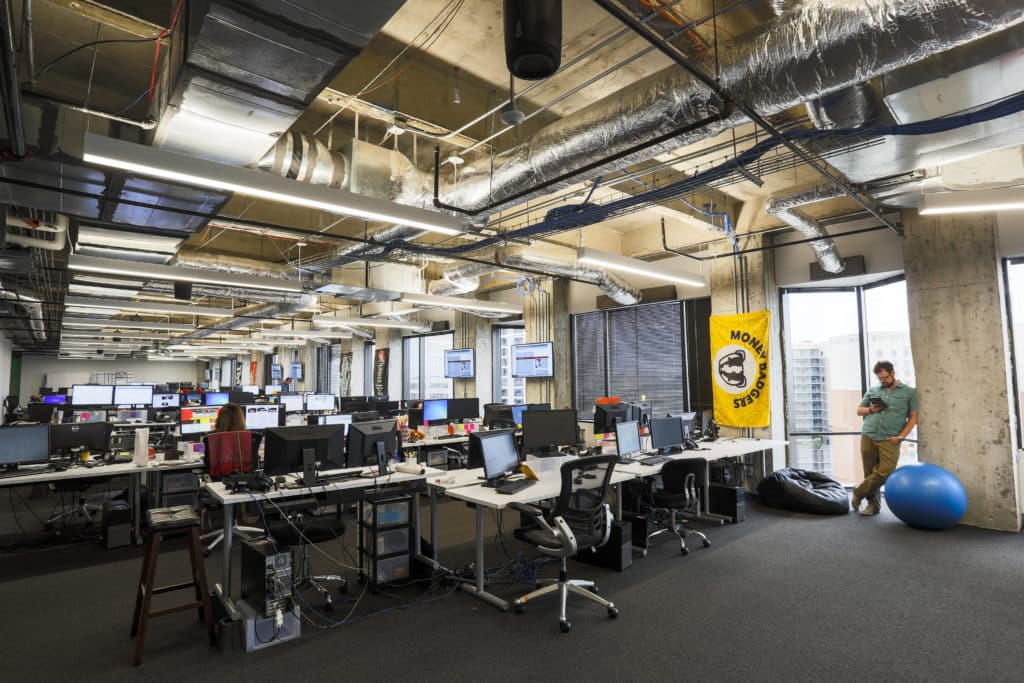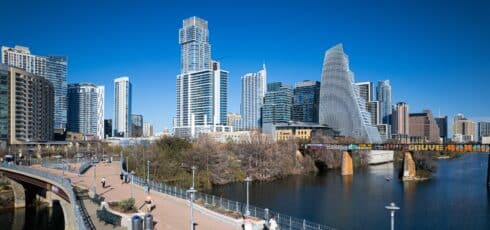The search for a new office starts with one essential step: correctly estimating the amount of space your company needs. But how do you know what that number is? And where do you start?
At AQUILA, we get this question every day. Our tenant representation specialists have helped hundreds of clients estimate their office space needs. We help them plan for the space they need now and anticipate their space needs for the future based on their projected growth.
Read Next: How to Find Office Space on Your Own, and Why You Shouldn’t
In this article we will explain:
- What average square allocations per employee are
- How to plan for growth
- How to calculate your office space needs
Let’s get started!
Determine How Much Space You Want Per Employee
To understand how much space you’ll need per employee, you’ll need to visualize your future office space. Picture it in your mind. Ask yourself these questions:
- Do you want to maximize the space each employee gets, or do you want to put as many employees as you can in the space?
- Do you envision having a lot of individual offices, or open areas with employees in cubes or workstations?
- Does each employee need an individual desk or is sharing possible?
- How many people are going to be in the office part-time? Permanently?
- How many remote employees will you have?
- What type of space does each department need to work efficiently?
- What is the operational goal the company wants to achieve with the space?
Now that you have a picture in your head, let’s convert that vision into some numbers.
Which of these best fits the image of what you see in your head?
- High Density (80 to 150 square feet per employee): Majority open seating with rows of small desks. May have a few private offices. Often seen in companies that house many different teams within the same space, as well as for sales, technology, coworking, or customer support offices.
- Average Density (150 to 250 square feet per employee): Mix of open cube or desk space and private offices. Traditional office layout.
- Spacious (250 to 500 square feet per employee): Majority of the space consists of large private offices. Historically seen in law firms.
To estimate how much space you need for your next office, multiply your employee headcount by the number of square feet per employee that best fits your density needs.
For example, a 25-person company with average space requirements would need an estimated 6,250 square feet (25 people x 250 square feet per employee). Keep in mind this number does not account for future growth, but we go into more detail on that topic later in this article.
To learn more about office density trends in Austin and across the nation, check out our special report Office Density Trends: How Workplace Density is Affecting Office Building Design.

Very dense office spaces often feature work benches as shown above, as well as large common areas for collaboration, recreation and more.
It is important to remember, that this article is meant to give you a ballpark range of how much space you will need. AQUILA highly recommends working with a tenant representative and engaging an architect to determine exact requirements.
Determine How That Space is Divided
When looking at square feet per employee, the common area square footage is included. So in an average office, not all 250 square feet will be devoted to the employee’s workplace, but rather a percentage of that square footage will be dedicated to the conference rooms, break areas, and communal spaces. In companies with private offices, employees with private offices will get a larger share of the total space than those in cubes or workstations.
In this section, we’ll explain how much space you should plan to dedicate to common areas and conference rooms and provide estimates as to how many square feet you will need for individual elements of the office.
Common Areas & Conference Rooms
How would you describe the common areas in your space? Are they expansive – including numerous conference rooms and a large kitchen area or are they minimal with just one conference room and maybe a break room?
Proactive common area design is important, as it can influence the flow of traffic through an office. Additionally, it can affect the sense of teamwork and unity in an office and can even alter employee productivity.
Think about what values you’d like your common areas to communicate, and where its layout provides opportunities for socialization. It’s common that available space can be a big limitation when designing your office’s common areas. If your company has limited space for common areas or a small overall footprint, it would be wise to plan more mixed-use areas, so you can get the most functionality from the limited square footage.
As a general rule of thumb, the denser the office space, the larger percent of your overall office space that should be committed to common areas.
This is because companies with employees working in mostly open office environments usually need more rooms for private meetings and work sessions, including smaller phone rooms and huddle rooms as well as larger conference rooms and communal workspaces.

Denser offices often feature large collaborative spaces for employees to work together, brainstorm, and relax.
For these denser offices, it is typical to see one conference room for every 10 employees. Meaning a 50-person office would need five conference rooms, private workstations, and/or communal areas.
For the more traditional offices, with 250 to 300 square feet per employee, you’ll need fewer communal workspaces. The typical ratio here would be one conference room per 20 employees. At this density, a 50-person office would need just two or three conference rooms.

Large conference rooms like this are important for companies that often present to clients or have large team meetings.
Estimated Size of Office Elements
Alright, so you have an image in your head of how you generally want your office to look. It may be highly efficient with lots of common areas for collaboration, or it may be a more traditional layout with private offices and a handful of conference rooms.
You have a vision of the reception area, cubicles, offices, conference room, break room, etc. But how much space are these areas actually taking up? Will you have enough room to fit all the common areas you need?
The below numbers should give you an idea of the typical sizes for different types of work areas within your overall office space:
- Large Private or Shared Office: 200 to 400 square feet
- Medium Private or Shared Office: 150 to 250 square feet
- Small Private Office: 90 to150 square feet
- Open Space Workstations: 60 to 110 square feet per employee
- Work Group Areas: 80 to 100 square feet per employee
Here are some estimated numbers to help you get an idea of how much space some aspects of an office environment consume, and to help you calculate how much space you actually need:
- Conference Room: 50 square feet + 25 square feet per person seated
- Reception Area: 100 to 200 square feet per person waiting
- Lunch/Break Room: 75 square feet + 25 square feet per person seated
- Halls/Corridors within the space: 20% to 30% of the total usable area
- Mail Room: 125 square feet
- File Room: 200 square feet
Additionally, surveying employees before creating your office plan can uncover potential needs you may have missed that could lead to increased productivity or employee morale.
Plan for Future Growth
When determining how much office space you need, it is vital to plan for growth. If you don’t plan for future growth you could potentially find yourself out of space after hiring new employees, and moving offices can be expensive.
The expense of terminating a lease early combined with the costs of finding and moving offices is not inexpensive. Because of this, it can be beneficial to add 10% to 20% to the total square footage you calculated to accommodate future growth. Building in your anticipated growth helps you expand your business without costly interruptions.
Read Next: 3 Types of Expansion Clauses in Commercial Leases: Understanding the Pros & Cons
Some necessary questions you need to ask yourself when thinking about the future are:
- What lease length would be appropriate? And how much employee growth would the lease need to support?
- Do I expect to add any staff in the next 12 to 24 months?
- Over what period of time will I add the staff?
- What kind of staff will I be adding, executive, administrative, or sales? Different types of employees will require different amounts of space
When thinking about the future of your office, it’s important to consider how employees’ work styles are evolving. Forward-thinking and flexibility are crucial when deciding how much office space per person and the type of environment you want to create.
A savvy tenant representative can help you analyze your company’s anticipated growth and help you plan for this in your needs analysis.
To learn more about how a tenant rep can help you during the office selection process, read our article 7 Benefits of Hiring a Tenant Representation Broker.
Next Steps
Once you have visualized your new office layout, you can get an estimate of how much space you need using our free Office Space Calculator.
Our calculation is derived from a carefully-designed formula that weighs the number of employees, the amount of space desired for each employee, and the use of common spaces.
The final projection should give you a good place to start in your search for a new office space.
While this calculator will provide you with an estimate of the amount of space your new office needs, it is based on industry standards and is not intended to act as a definitive valuation. We highly recommend that you seek the expertise of one of our brokers, who will be able to speak directly with you about your specific needs and the best ways to accommodate those needs within the market.
If you’re ready to start your search for office space, read our Ultimate Guide to Finding Office Space.


Popular Articles:













